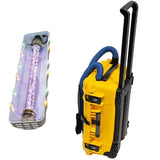UVC Handheld
Ultraviolet UVC handheld lights are relatively light, small, and use low wattage germicidal bulbs. The light from the fixtures can be shined directly onto surfaces for UV disinfection. They are especially appropriate when space is limited, or where surface disinfection is desired in hard-to-reach areas. Common application areas include laboratories, clean rooms, operating rooms, and manufacturing operations.
Handheld UVC Buying Tips
Handheld UVC units (often referred to as wands) are one of the most portable and versatile UVC fixtures available. But not all handheld devices are created equal. Here are a few factors to consider when buying a handheld ultraviolet disinfection wand.
Intensity
The higher the wattage of a handheld device, the more UV output it will have. The more UV output, the faster it will deactivate harmful microbes.
In general, higher-wattage UVC handhelds will cost more and the germicidal bulbs will be more expensive or more bulbs will be used in the fixture.
For deactivating small viruses or bacteria, a low-powered handheld may be enough. But for medical settings or when used to eradicate hardier molds and fungi, a higher-powered fixture makes more sense.
Length
In general, higher-powered UVC fixtures use longer light bulbs. The shorter the fixture, the more portable it is, and the less likely you'll bump it into things and damage the device or bulb.
A longer fixture, though, gives you more coverage of the UV light, making it faster to sanitize tables, desks, countertops, and other surfaces.
Some manufacturers include additional technology in their devices, which may increase the overall length of the unit, despite using the exact same length of bulb as a shorter unit overall.
Material
Construction material can be a secondary concern when buying a handheld UVC, but it can make a difference in several ways.
Units constructed of stainless steel are often sturdier than those made of plastic. And one good thing to check for is the presence of a reflective material inside the unit to direct light downwards.
In some cases, the type of material used can relate to the warranty of the fixture. Plastic fixtures often have a shorter warranty period than steel.
In addition, UVC light can degrade plastics, resin, rubber, and other materials, but does not degrade steel. Differences in construction material can make a difference in price, but also longevity of the fixture.
Power Options
Another secondary concern is power options. Many low- and medium-powered fixtures on the market are battery-operated and cordless, while most of the commercial, higher-powered fixtures are designed to be plugged in.
Cordless fixtures provide portability, although charging and replacement batteries become a concern, in addition to replacement UVC bulbs. But the extra cost may easily justify itself in ease of use.
Handheld UVC Germicidal Fixture - 5.7W UV Output - 18" Length - 1 Shatterproof Bulb
American Ultraviolet HH-18-120X
$699.00
$699.00
Far UV Technologies Krypton-Plus UVC Excimer Handheld Fixture - 150W - 18" Length - 1 Excimer Lamp
Far UV Technologies Krypton-PLUS
$9,999.00
$9,999.00


